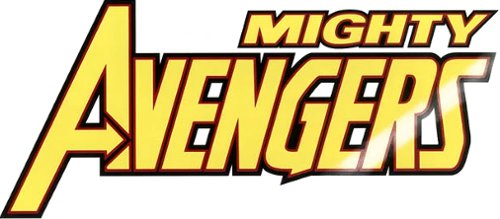The Heroic Age (2010-2013)
It soon became apparent that Marvel wanted to use the end of the Siege event as a new starting point for the Avengers. The same month as the final issue of the miniseries hit the stands, so did 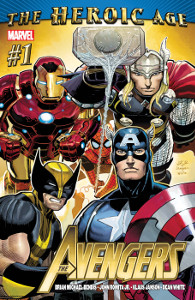 the final issues of multiple Avenger titles – New Avengers, Mighty Avengers, Avengers: the Initiative and (less surprisingly) Dark Avengers. Of course, the Avengers were to continue and the following month three new series debuted. Given the popularity of the title for the last few years, the first book was unsurprisingly a renumbered New Avengers (2nd series). However, rather than a new Mighty Avengers, the second new book was simply Avengers, making it the fourth series to bear that name. The third title was a brand new book named Secret Avengers, the first title of that name. Although the Avengers titles had been relaunched, the creative director behind it had not. This time, however, Brian Michael Bendis wore two writing hats and wrote both Avengers (4th series) and New Avengers (1st series) and would continue to do so through each book’s run. This first Secret Avengers book was helmed by Ed Brubaker.
the final issues of multiple Avenger titles – New Avengers, Mighty Avengers, Avengers: the Initiative and (less surprisingly) Dark Avengers. Of course, the Avengers were to continue and the following month three new series debuted. Given the popularity of the title for the last few years, the first book was unsurprisingly a renumbered New Avengers (2nd series). However, rather than a new Mighty Avengers, the second new book was simply Avengers, making it the fourth series to bear that name. The third title was a brand new book named Secret Avengers, the first title of that name. Although the Avengers titles had been relaunched, the creative director behind it had not. This time, however, Brian Michael Bendis wore two writing hats and wrote both Avengers (4th series) and New Avengers (1st series) and would continue to do so through each book’s run. This first Secret Avengers book was helmed by Ed Brubaker.
Through the year in which the Dark Reign event was going on, it could be argued that the Marvel Universe had been at its darkest. During that time, for all intents and purposes, the bad guys had won. Perhaps to contrast this bleakness, the relaunched titles were a were a callback to brighter and more upbeat times. Even the banner theme across most of the titles reflected this – “the Heroic Age.” Indeed, Avengers (4th series) seemed like the Avengers of old, starring some of the most steadfast of their team: Iron Man, Thor, Hawkeye and Captain America (the Bucky Barnes version). Fleshing out the team were Spider-Man, Wolverine and Spider-Woman. Their first villain was perennial Avenger foe Kang. The title’s second main storyline even added a Hulk (the red one).
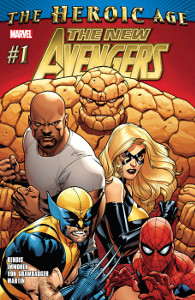 New Avengers (2nd series) was slightly different. While the team in Avengers was meant to interact with government departments on a more official level, the recent repeal of the Registration Act allowed the team branch in New Avengers to be simply heroes on their own terms. Led by Luke Cage, this team included Iron Fist, Ms. Marvel, Mockingbird, Thing, Doctor Strange and… apparently both Spider-Man and Wolverine, whose powers now included amazing time management skills. While the other Avengers made their base in Stark Tower, Luke’s group stayed in Avengers Mansion, which Tony Stark sold to Luke Cage for a dollar to demonstrate his independence.
New Avengers (2nd series) was slightly different. While the team in Avengers was meant to interact with government departments on a more official level, the recent repeal of the Registration Act allowed the team branch in New Avengers to be simply heroes on their own terms. Led by Luke Cage, this team included Iron Fist, Ms. Marvel, Mockingbird, Thing, Doctor Strange and… apparently both Spider-Man and Wolverine, whose powers now included amazing time management skills. While the other Avengers made their base in Stark Tower, Luke’s group stayed in Avengers Mansion, which Tony Stark sold to Luke Cage for a dollar to demonstrate his independence.
While both the Avengers and New Avengers teams harkened back to a more innocent age, Secret Avengers maintained a slightly darker tone. As the adjective preceding the team’s title on the cover suggested, this group of Avengers was clandestine. Following Steve Rogers’ assassination, the mantle of Captain America had fallen to Bucky Barnes, formerly the Winter Soldier. Although 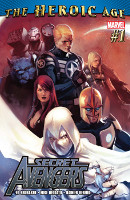 he donned the costume again shortly after his return, Rogers decided to allow Bucky to continue in the role, instead accepting the role as civilian oversight of the Avengers teams. Now known simply as “Commander Rogers” as he tried to reassemble SHIELD out of the scraps of HAMMER, Steve decided that he needed a “black ops” team to handle the world’s deadliest threats, and do so out of the spotlight. To that end, Rogers recruited Agent 13, War Machine, Black Widow, Moon Knight, the “irredeemable” Ant-Man, Beast, Valkyrie and Nova. Aiding the team from time to time were the Prince of Orphans and Shang Chi. Ed Brubaker’s recent run on Captain America had been as much “spy thriller” as superhero comic, and the theme of Secret Avengers suited his style.
he donned the costume again shortly after his return, Rogers decided to allow Bucky to continue in the role, instead accepting the role as civilian oversight of the Avengers teams. Now known simply as “Commander Rogers” as he tried to reassemble SHIELD out of the scraps of HAMMER, Steve decided that he needed a “black ops” team to handle the world’s deadliest threats, and do so out of the spotlight. To that end, Rogers recruited Agent 13, War Machine, Black Widow, Moon Knight, the “irredeemable” Ant-Man, Beast, Valkyrie and Nova. Aiding the team from time to time were the Prince of Orphans and Shang Chi. Ed Brubaker’s recent run on Captain America had been as much “spy thriller” as superhero comic, and the theme of Secret Avengers suited his style.
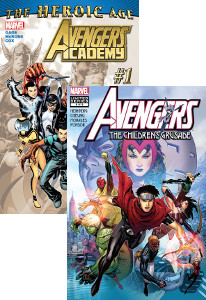 A month after the core three Avengers titles’ launched, the franchise received a new spinoff. Much like the recently canceled title Avengers: the Initiative, the series Avengers Academy followed the exploits young, super-powered youths, who were being trained by veteran Avengers to use their powers and become heroes. However, in time, the trainees learned a disturbing truth: they had been identified by Norman Osborn during his time in power as possible villains to be recruited and the Avengers training them were attempting to avoid this from happening. In addition, Allan Heinberg returned to the Young Avengers he created for a fifth title, the bi-monthly Avengers: The Children’s Crusade #1-9, which focused on the mental rehabilitation of the Scarlet Witch and her relationship with Asgardian (now named Wiccan) and Speed, specifically whether they were her reincarnated children.
A month after the core three Avengers titles’ launched, the franchise received a new spinoff. Much like the recently canceled title Avengers: the Initiative, the series Avengers Academy followed the exploits young, super-powered youths, who were being trained by veteran Avengers to use their powers and become heroes. However, in time, the trainees learned a disturbing truth: they had been identified by Norman Osborn during his time in power as possible villains to be recruited and the Avengers training them were attempting to avoid this from happening. In addition, Allan Heinberg returned to the Young Avengers he created for a fifth title, the bi-monthly Avengers: The Children’s Crusade #1-9, which focused on the mental rehabilitation of the Scarlet Witch and her relationship with Asgardian (now named Wiccan) and Speed, specifically whether they were her reincarnated children.
In the summer of 2011, a new crossover event rocked the Avengers’ status quo. Writer Matt Fraction delved into the fictional backstory of the Marvel Universe’s Asgard. introducing the 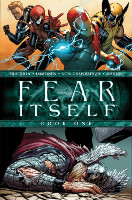 forgotten brother of Odin. More powerful than the rest of the Norse gods, Odin’s brother, known as “the Serpent,” unleashed chaos in the world and fed on the fear it produced. The core of the series was a 7-issues maxiseries named Fear Itself and ran from June to December 2011. All four monthly Avengers titles participated in the event, as did numerous titles through the Marvel line, including the X-Men. Additionally, there were nearly a dozen miniseries and one shots to flesh out side stories. Consequences of Fear Itself included Steve Rogers becoming Captain America again, Hawkeye taking over the Secret Avengers, Thor dying temporarily and Wolverine and Spider-Man being mercifully limited to one Avengers team.
forgotten brother of Odin. More powerful than the rest of the Norse gods, Odin’s brother, known as “the Serpent,” unleashed chaos in the world and fed on the fear it produced. The core of the series was a 7-issues maxiseries named Fear Itself and ran from June to December 2011. All four monthly Avengers titles participated in the event, as did numerous titles through the Marvel line, including the X-Men. Additionally, there were nearly a dozen miniseries and one shots to flesh out side stories. Consequences of Fear Itself included Steve Rogers becoming Captain America again, Hawkeye taking over the Secret Avengers, Thor dying temporarily and Wolverine and Spider-Man being mercifully limited to one Avengers team.
Ever since the 2008 release of the first Iron Man film starring Robert Downey Jr., the films of the “Marvel Cinematic Universe” had been building to their logical conclusion – an Avengers film. 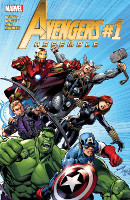 Unfortunately, none of the teams featured in any of the current Avengers titles looked exactly like the team that would be appearing in the film, something that might confuse movie fans who found their way into comic shops to learn more about the heroes they had just seen. To give shops something to sell to these people and ease them into the Avengers in print, early 2012 saw the release of a new title named “Avengers Assemble,” written by Brian Michael Bendis and starring the same characters in the film. Bendis only stayed on the book for the first eight issues, after which it was turned over to Kelly Sue DeConnick. With the exception of two issues that were part of a crossover and co-plotting credit with Warren Ellis in the last few issues, DeConnick would write the series until its final issue of #25 in 2014.
Unfortunately, none of the teams featured in any of the current Avengers titles looked exactly like the team that would be appearing in the film, something that might confuse movie fans who found their way into comic shops to learn more about the heroes they had just seen. To give shops something to sell to these people and ease them into the Avengers in print, early 2012 saw the release of a new title named “Avengers Assemble,” written by Brian Michael Bendis and starring the same characters in the film. Bendis only stayed on the book for the first eight issues, after which it was turned over to Kelly Sue DeConnick. With the exception of two issues that were part of a crossover and co-plotting credit with Warren Ellis in the last few issues, DeConnick would write the series until its final issue of #25 in 2014.
For the most part, throughout their histories, the Avengers and X-Men had been friends and allies. However, their biggest divide in years arose in the massive storyline event titled “Avengers vs. X-Men.” The conflict between the X-Men and the Avengers began when the Avengers were warned by a member of the Nova Corps that the Phoenix was returning to Earth. Surmising that it was coming for Hope Summers, who had remained on Utopia with Cyclops’ group during the X-Men’s 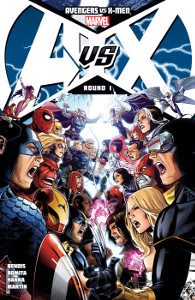 “Schism,” Wolverine convinced the Avengers to travel to the island nation in force and take the young woman into custody. Though Captain America politely asked Cyclops to comply, the SHIELD helicarrier filled by every available Avenger was undeniably meant to be a threat. Undeterred, Cyclops refused and the Avengers attacked.
“Schism,” Wolverine convinced the Avengers to travel to the island nation in force and take the young woman into custody. Though Captain America politely asked Cyclops to comply, the SHIELD helicarrier filled by every available Avenger was undeniably meant to be a threat. Undeterred, Cyclops refused and the Avengers attacked.
Though Hope escaped arrest, the tide did not turn for the X-Men until a device built by Iron Man to contain the approaching Phoenix Force had an unintended side effect. Instead of entering Hope alone, the Phoenix Force split into five equal parts, entering Cyclops, Emma Frost, Colossus, Magik and Namor. In the two weeks that followed, the “Phoenix Five” used their godlike powers to reshape the world, providing unlimited, clean energy for free, turning desert into farmland and ending all armed conflicts across the planet. Despite their altruism, the remaining Avengers distrusted any with such power and worked against them. Ultimately, four of the five were depowered, with Cyclops being the last to retain all of the power within him. As the Avengers feared, Cyclops eventually lost control and became Dark Phoenix. With the help of Hope and the restored Scarlet Witch, the Phoenix Force was removed and apparently extinguished forever. However, the conflict was not without its victims and Professor X was killed by Cyclops while under the control of the Dark Phoenix. Following the conflict, Cyclops was arrested.
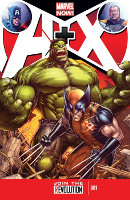 Most of the storyline was covered in the 12 issues of the primary Avengers vs. X-Men miniseries, which ran from May to December 2012. However, almost all Avengers or X-titles during this time had at least some issues which crossed over in the event. Likewise, there was a 6 issue AvX: VS miniseries which showed the in-depth battles between individual X-Men and Avengers which had only been hinted at during the main miniseries. Following the crossover, there were several “What Ifs…?” and a follow-up A+X series showing reconciliation between the two teams of heroes with missions in which members of each team would team-up. This series ran for 18 issues between October 2012 & March 2013. Not to be overlooked, there was an A-Babies vs. X-Babies oneshot in late 2012.
Most of the storyline was covered in the 12 issues of the primary Avengers vs. X-Men miniseries, which ran from May to December 2012. However, almost all Avengers or X-titles during this time had at least some issues which crossed over in the event. Likewise, there was a 6 issue AvX: VS miniseries which showed the in-depth battles between individual X-Men and Avengers which had only been hinted at during the main miniseries. Following the crossover, there were several “What Ifs…?” and a follow-up A+X series showing reconciliation between the two teams of heroes with missions in which members of each team would team-up. This series ran for 18 issues between October 2012 & March 2013. Not to be overlooked, there was an A-Babies vs. X-Babies oneshot in late 2012.
In addition to these limited series, a new, ongoing Uncanny Avengers series, the first of its name, began in December 2012. The premise of this series was that the Avengers realized that they had 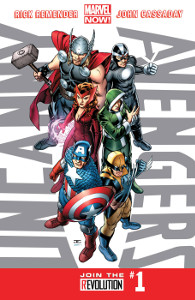 not done enough to assist mutants in their plight of coexistence with humans. As such, Captain America mandated the creation of a “Unity Squad,” comprised of both X-Men and Avengers, as to show the world that it could be done. This new title attempted to restore the public image of the Scarlet Witch and picked up on her old relationship with Wonder Man. Unfortunately, neither Captain America nor the new Unity Squad were prepared when the Red Skull arose to stoke anti-mutant sentiments using telepathy he had acquired through the lobotomized brain of Professor Xavier’s corpse. Plagued by both the Red Skull and the Apocalypse Twins, the children of Archangel while under the influence of Apocalypse’s programming, the Unity Squad barely survived against their enemies. The series ended with #25 in December 2014, which led directly into the Avengers & X-Men: AXIS miniseries & crossover.
not done enough to assist mutants in their plight of coexistence with humans. As such, Captain America mandated the creation of a “Unity Squad,” comprised of both X-Men and Avengers, as to show the world that it could be done. This new title attempted to restore the public image of the Scarlet Witch and picked up on her old relationship with Wonder Man. Unfortunately, neither Captain America nor the new Unity Squad were prepared when the Red Skull arose to stoke anti-mutant sentiments using telepathy he had acquired through the lobotomized brain of Professor Xavier’s corpse. Plagued by both the Red Skull and the Apocalypse Twins, the children of Archangel while under the influence of Apocalypse’s programming, the Unity Squad barely survived against their enemies. The series ended with #25 in December 2014, which led directly into the Avengers & X-Men: AXIS miniseries & crossover.
The end of the AvX crossover also marked the beginning of the end of Bendis’ tenure as director of the Avengers franchise. Having begun his run nearly eight years before by disassembling the team, Bendis spent his last months on both of the main books putting them back as he had found them. The Wasp, who it was believed had died during the Secret Invasion, was found alive. The Vision, who had been ripped apart during Avengers Disassembled, was repaired and functional. Wonder Man, who had publically rejected the Avengers, now asked for forgiveness. Even Doctor Strange, who had lost the mantle of Sorcerer Supreme a few years before, regained the title. In January 2013, Avengers (4th series) and New Avengers (2nd series) ended with #34 each. Two months later, Secret Avengers (1st series) ended with #37.
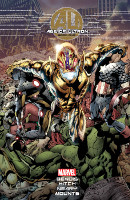 Although he had left the Avengers titles proper, Bendis was not finished with the Avengers altogether. A few months later in May, the Age of Ultron crossover began. Not to be confused with the second Avengers film released a few years later in 2015, this storyline told a time-traveling tale in which the Avengers of the future attempted to undo the ruins of their world by preventing Ultron and his army of Ultron Sentinels from rising to power. Although the miniseries was larger than average at ten issues, due to double shipping the story was told over only four months, between March and June 2013, and with far fewer tie-ins than other recent crossovers.
Although he had left the Avengers titles proper, Bendis was not finished with the Avengers altogether. A few months later in May, the Age of Ultron crossover began. Not to be confused with the second Avengers film released a few years later in 2015, this storyline told a time-traveling tale in which the Avengers of the future attempted to undo the ruins of their world by preventing Ultron and his army of Ultron Sentinels from rising to power. Although the miniseries was larger than average at ten issues, due to double shipping the story was told over only four months, between March and June 2013, and with far fewer tie-ins than other recent crossovers.
Change was also in the air with the Avengers’ youth title, Avengers Academy. The series had come to an end with #39 in January 2013. The following month, the story of most of its characters continued with a new title named Avengers Arena. A complete change of settings, the readers learned that all of the youths had been kidnapped and placed in one of the most elaborate 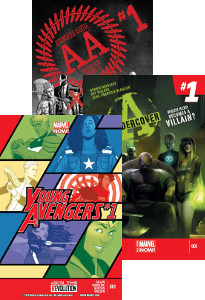 Murderworlds designed to date by the assassin Arcade. Although the series clearly owed its inspiration to the popular Hunger Games franchise, Avengers Arena was a critical success during its 18-issue run. A few months after the story’s end in January 2014, the characters that survived were featured in a sequel series named Avengers Undercover, which chronicled their attempts to infiltrate the Masters of Evil. That series ran for ten issues, coming to an end in November 2014.
Murderworlds designed to date by the assassin Arcade. Although the series clearly owed its inspiration to the popular Hunger Games franchise, Avengers Arena was a critical success during its 18-issue run. A few months after the story’s end in January 2014, the characters that survived were featured in a sequel series named Avengers Undercover, which chronicled their attempts to infiltrate the Masters of Evil. That series ran for ten issues, coming to an end in November 2014.
When Avengers Academy morphed into Avengers Arena, this was not the only youth-centered Avengers series to grace the stands. A month later in March 2013, the Young Avengers returned to their own series. These characters had been inactive for over a year since the Children’s Crusade finally ended. When the second Young Avengers title hit the stands, writer Kieron Gillen used the series to explore Hulkling’s alien past and Wiccan’s destiny to become the magical force Demiurge. The series came to an end with #15 in March 2014 after Gillen wrapped up the threads of his story.
